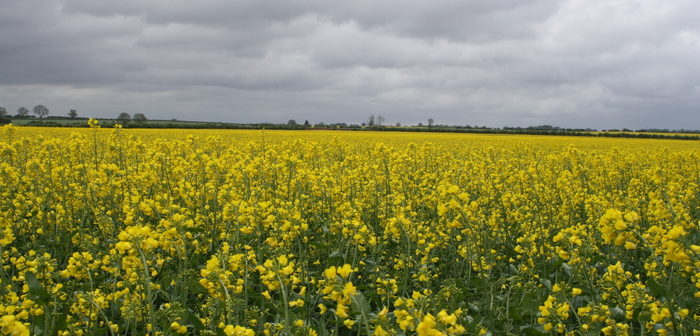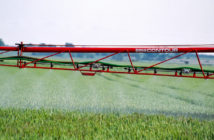With oilseed rape prices significantly higher than this time last year, there could be more of the crop going into the ground this autumn. But before making a final decision, leading agronomy firm Hutchinsons urges growers to think carefully about how they will get crops to perform well amidst the many establishment challenges.
Cabbage stem flea beetle has become the greatest concern in many areas, but seedbed moisture, slugs and pigeons remain constant threats to establishing crops successfully and building yield potential.
Yorkshire-based Hutchinsons agronomist David Stead believes the key to success is drilling crops early into good conditions to establish strong, healthy, deep-rooted plants with greater resilience.
“Generally, the earlier oilseed rape is sown, the better it performs. Although flea beetle pressure is quite seasonal in this region, it’s clear that late sowing increases the risk of crop failure, and we’re almost at a point where the 15-20 August is the cut-off for drilling. Putting seed on during the first week of September and hoping for the best simply doesn’t work.”
Sowing into seedbeds with adequate moisture, at an even depth with good seed-to-soil contact is vital for strong, consistent establishment, which can make subsequent pest pressure more tolerable. However, he acknowledges this is often challenging given the vagaries of the British weather, and narrow drilling window, particularly in northern areas.

David Stead.
“There aren’t usually that many winter wheat crops cleared by the 15 August here, so growers have got to think longer-term about where oilseed rape fits within the rotation and not be too reactive. For many, it means growing winter barley or perhaps an early-maturing wheat variety before oilseed rape to allow a timely entry.”
Optimising nutrition in the seedbed and again early in the spring will help exploit the natural vigour of conventional and hybrid varieties, Mr Stead says, and it is also important to control any other pests – namely slugs and pigeons – through autumn and winter.
“If crops are living with flea beetle larvae inside the stems, we cannot afford to have anything else that sets them back.”
Hutchinsons technical support manager Neil Watson says before deciding to grow any crop, oilseed rape being no exception, it is important to identify the yield required to break even and then ask whether this can be practicably achieved.
“Consider alternative break crops and other options, such as the two-year legume mix within the Countryside Stewardship Scheme, which at a payment of £522/ha, effectively sets a ‘floor’ for the potential returns possible and means an osr yield of at least 2.3 t/ha is needed to make this a better option financially.”
Mr Watson and Hutchinsons colleague Dick Neale highlight six ways growers can manage the risks to crop establishment, as outlined below.
Six-point plan to better OSR results:
- Rotation: Oilseed rape should ideally be grown no closer than one year in five or six to avoid building pressure from pests like CSFB and diseases such as clubroot. A wider rotation gives more time to plan the best entry for early osr establishment, which is often a preceding winter barley crop. Early-harvested wheat, or in bad black-grass situations where a double-break is needed, peas, can also be suitable entries, both for timeliness of drilling and for leaving soils in better condition after harvest than they may be following winter wheat.
- Soil management: Underlying soil structure issues, such as compaction, must be rectified in preceding seasons, as current pressures on establishment mean it is not effective to combine osr sowing with subsoiling. Aim for a friable surface that osr can be drilled straight into, as preserving seedbed moisture is critical to establishing rape successfully at what is usually a dry time of year.
- Drilling: Given rape’s small seed size and the need for fast, even establishment to counter pest threats, it is essential to maximise seed-to-soil contact and achieve consistently accurate sowing depth, whether using a tine or disc-based drill. Avoid sowing any deeper than 5 cm otherwise seed is unlikely to germinate. Also, resist the temptation to push seed rates too high as this is likely to result in more plants with thinner stems prone to CSFB larval damage. It also exacerbates intra-crop competition for water and nutrients. Early sowing at lower seed rates generally gives bigger plants able to develop stronger stems, well-branched canopies and more extensive root systems. Typically, 25-30 established plants/m2 is optimum for yield, but 40-50/m2 may give leeway for some establishment losses.
- Nutrition: Placement fertiliser at drilling can benefit osr establishment as nutrients are more easily available to young plants with limited scavenging ability. This is particularly true for phosphate which is vital for root development, but has poor soil mobility so must be close to the seed. Seedbed nitrogen is also beneficial for early growth. Typically around 30 kg/ha of each should be sufficient. Early spring nitrogen may also be beneficial to “feed” spring vigour.
- Trap crops: Leaving volunteer osr to grow in other fields after harvest can provide a useful “trap crop” to divert CSFB away from newly-sown crops. However, destruction must be timed carefully to reduce the risk of adults migrating into the new crop. Also, beware that volunteer osr can dry soils significantly, potentially creating issues for a following winter wheat, so consider raking out a proportion of osr volunteers and drill other catch crop species into it. The variation in root structures of plants like buckwheat, berseem clover or vetch, improves moisture management.
- Manage other pests: Slugs and pigeons remain major threats throughout autumn and winter. The yield impact of any damage is likely to be exacerbated where crops are already struggling to overcome CSFB. Monitor closely and apply appropriate controls where required.




